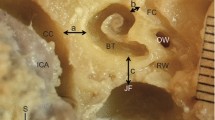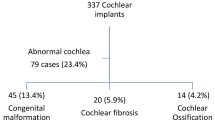Abstract
Purpose
In this study, we aimed to introduce the facial nerve as a new anatomical landmark which can be used in ossified cochleas during cochlear implantation. We also set out to define a safe line to preserve the internal auditory canal (IAC) while drilling the basal turn of the cochlea.
Methods
Thirty patients who had temporal computed tomography (CT) were studied. The distances from the facial nerve and the round window to the IAC, carotid artery, and jugular bulb were measured in the reformatted CT images. We have created a line in the direction of the stapedial tendon from the round window to the IAC and called it ROWIAC (Round window–IAC) line. We have investigated whether this line intersects the IAC and measured the distances from this line to the IAC.
Results
Fifty-four temporal CT scans were included to the study. The mean distances from the facial nerve to the IAC, carotid artery, and jugular bulb were 8.8 ± 0.9, 15.0 ± 2.0, and 12.2 ± 2.9 mm, respectively. The mean distances from the round window to these structures were 3.8 ± 0.7, 9.4 ± 2.2, and 8.3 ± 2.9 mm, respectively. ROWIAC line did not intersect the IAC in any of the patients. The mean distance between this line and the IAC was 0.8 ± 0.4 mm.
Conclusion
We propose that facial nerve and ROWIAC line can be used as potential landmarks during cochlear implantation in ossified cochleas to protect the adjacent neurovascular structures.




Similar content being viewed by others
References
Paparella MM, Sugiura S (1967) The pathology of suppurative labyrinthitis. Ann Otol Rhinol Laryngol 76:554–586
Suga F, Lindsay JR (1977) Labyrinthitis ossificans. Ann Otol Rhinol Laryngol 86:17–29
Smullen JL, Balkany TJ (2005) Implantation of the ossified cochlea. Oper Tech Otolaryngol Head Neck Surg 16:117–120
Kaya S, Paparella MM, Cureoglu S (2016) Pathologic Findings of the Cochlea in Labyrinthitis Ossificans Associated with the Round Window Membrane. Otolaryngol Head Neck Surg 155(4):635–640
deSouza C, Paparella MM, Schachern P, Yoon TH (1991) Pathology of labyrinthine ossification. J Laryngol Otol 105:621–624
Roland JT Jr, Coelho DH, Pantelides H, Waltzman SB (2008) Partial and double-array implantationof the ossified cochlea. Otol Neurotol 29(8):1068–1075
Balkany TJ, Gantz B, Nadol JB (1988) Multichannel cochlear implants inpartially ossified cochleas. Ann Otol Rhinol Laryngol 97:3–7
Gantz BJ, McCabe BF, Tyler RS (1988) Use of multi-channel cochlearimplants in obstructed and obliterated cochleas. Otolaryngol Head Neck Surg. 98:72–81
Hodges AV, Balkany TJ, Gomez-Marin O et al (1999) Speech recognitionafter implantation of the ossified cochlea. Am J Otol 20:453–456
Yan T, Zong F, Ma X et al (2019) Cochlear implantation in patients with ossified cochleas. Am J Otol 40(2):183–186
Singla A, Sahni D, Gupta AK, Loukas M, Aggarwal A (2014) Surgical anatomy of round window and itsimplications for cochlear implantation. Clin Anat 27:331–336
Singla A, Gupta T, Sahni D, Gupta AK, Aggarwal A (2017) Topography of neurovascular structures in relation toround window and how it relates to cochlear implantation. Surg Radiol Anat 39(12):1309–1316
Coelho DH, Roland JT Jr (2012) Implanting obstructed and malformed cochleae. Otolaryngol Clin North Am 45(1):91–110
Leal Mde C, Caldas Neto Sda S (2015) The anatomical orientation of the middle turn of the cochlea: importance during surgical implantation of the ossified cochlea. Otol Neurotol 36(3):406–408
Wysocki J, Skarzynski H (1998) Distance between the cochlea andadjacent structures related to cochlear implant surgery. Surg Radiol Anat 20:267–271
Ying YL, Lin JW, Oghalai JS, Williamson RA (2013) Cochlear implant electrodemisplacement: incidence, evaluation, and management. Laryngoscope 123:757–766
Nevoux J, Loundon N, Leboulanger N, Roger G, Ducou Le PointeGarabedian HEN (2010) Cochlear implant in the carotid canal. Case report and literaturereview. Int J of Pediatr Otorhinolaryngol 74:701–703
Jain S, Gaurkar S, Deshmukh PT et al (2019) Applied anatomy of round window and adjacent structures of tympanum related to cochlear implantation. Braz J Otorhinolaryngol 85(4):435–446
Mehanna AM, Gamaleldin OA, Fathalla MF (2019) The misplaced cochlear implant electrode array. Int J Pediatr Otorhinolaryngol 117:96–104
Jiang Y, Chen Y, Yao J, Tian Y, Su L, Li Y (2015) Anatomic assessment of petrous ınternal carotid artery, facial nerve, and cochlea through the anterior transpetrosal approach. J Craniofac Surg 26(7):2180–2183
Acknowledgements
The authors would like to thank Ms. Cigdem Altunok, Department of Bioistatistics, Yeditepe University School of Medicine, for her support with the statistical analyses.
Funding
None.
Author information
Authors and Affiliations
Corresponding author
Ethics declarations
Conflict of interest
The authors declare that they have no conflict of interest.
Ethical approval
All procedures performed in studies involving human participants were in accordance with the ethical standards of the Institutional ethics committee and with the ethical standards as laid down in the 1964 Declaration of Helsinki and its later amendments or comparable ethical standards.
Informed consent
Informed consent was obtained from all individual participants included in the study.
Additional information
Publisher's Note
Springer Nature remains neutral with regard to jurisdictional claims in published maps and institutional affiliations.
Rights and permissions
About this article
Cite this article
Yilmazer, R., Karatay, E., Akbulut, S. et al. Anatomical landmarks for cochlear implantatıon in ossifıed cochleas. Eur Arch Otorhinolaryngol 277, 3301–3306 (2020). https://doi.org/10.1007/s00405-020-06044-1
Received:
Accepted:
Published:
Issue Date:
DOI: https://doi.org/10.1007/s00405-020-06044-1




